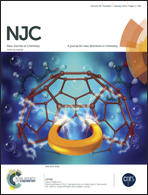A sensitive photoelectrochemical immunoassay based on mesoporous carbon/core–shell quantum dots as donor–acceptor light-harvesting architectures
Abstract
Herein, we demonstrate the protocol of a label-free photoelectrochemical (PEC) immunoassay on the basis of ordered mesoporous carbon (CMK-3) and water-soluble CdSe@ZnS core–shell quantum dots (QDs) coupled with a biospecific interaction for the ultrasensitive detection of human immunoglobulin (antigen, H-IgG) as a model protein. The CMK-3 was dispersed with chitosan (CS-CMK-3), which contains a large amount of amino groups (–NH2), and the CdSe@ZnS QDs were treated with thioglycolic acid, which contains carboxylic acid groups (–COOH). The layer-by-layer assembling of CdSe@ZnS QDs and CS-CMK-3 achieved through the covalent bonding of –COOH and –NH2 was employed as a photoactive antibody (Ab) immobilization matrix. Improved sensitivity was achieved through the synergistic effect of the excellent electrical conductivity and high specific surface area of CMK-3, as well as the high photon-to-electron conversion efficiency of CdSe@ZnS QDs. The photoexcitation of a CMK-3/CdSe@ZnS QDs-modified ITO electrode potentiostated at 0 V (vs. Ag/AgCl) under white light led to a stable anodic photocurrent. To perform the immunoassay, anti-human immunoglobulin (antibody, anti-H-IgG) was conjugated onto the CdSe@ZnS QDs-modified electrode by using EDC–NHS coupling reactions between –COOH of CdSe@ZnS QDs and –NH2 of the antibody. The concentrations of H-IgG were measured through the decrease in photocurrent intensity resulting from the increase in steric hindrance due to the formation of the immunocomplex. Under the optimal conditions, a linear relationship between photocurrent decrease and H-IgG concentration was obtained in the range 10 pg mL−1–100 ng mL−1 with a detection limit of 5 pg mL−1. This strategy opens a simple perspective for the application of mesoporous conductive material and core–shell QDs as light-harvesting architecture, which might be of great significance in PEC bioanalysis in the future.


 Please wait while we load your content...
Please wait while we load your content...